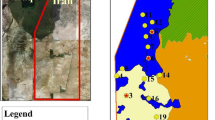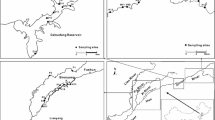Abstract
Lake Taihu provides vital ecological services for humans in China; it receives a great deal of attention regarding its ecological and environmental conditions. In this study, the ecological risks of eight individual polycyclic aromatic hydrocarbons (PAHs) in water were assessed using probabilistic distributions of the hazard quotient based on Monte Carlo simulation. The results show that the 95th percentile of the hazard quotients ranged from 0.00074 to 2.831, and the ecological risk of Flua was highest, followed by, in descending order of risk, B[a]P > Pyr > Ant > Phe > Flu > Ace > Chr. The probabilities of hazard quotients exceeding a decision criteria of 0.3 were 18.09%, 6.51%, 3.76%, and 2.85% for Flua, B[a]P, Pyr, and Ant, respectively, indicating their potential ecological risks to aquatic organisms. The spatial distribution of hazard quotients for these four individual PAHs with potential ecological risk were obtained using Geographic Information System (GIS), and similar spatial distribution patterns were also observed in the lake. The highest ecological risks of these four individual PAHs to aquatic organisms were found in Meiliang Bay, followed by Gonghu Bay and Xukou Bay. The uncertainty within the ecological risk assessment was also discussed.



Similar content being viewed by others
References
Aldenberg, T. (1993). Confidence limits for hazardous concentrations based on log-logistically distributed NOEC toxicity data. Ecotoxicology and Envrionmental Safety, 25(1), 48–63.
Carriger, J. F., & Rand, G. M. (2008). Aquatic risk assessment of pesticides in surface waters in and adjacent to the Everglades and Biscayne National Parks: I hazard assessment and problem formulation. Ecotoxicology, 17(7), 660–679.
Chiang, K. C., Chio, C. P., Chiang, Y. H., & Liao, C. M. (2009). Assessing hazardous risks of human exposure to temple airborne polycyclic aromatic hydrocarbons. Journal of Hazardous Materials, 166(2–3), 676–685.
Countway, R. E., Dickhut, R. M., & Canuel, E. A. (2003). Polycyclic aromatic hydrocarbon (PAH) distributions and associations with organic matter in surface waters of the York River, VA Estuary. Organic Geochemistry, 34(2), 209–224.
De Luca, G., Furesi, A., Leardi, R., Micera, G., Panzanelli, A., & Piu, P. C. (2004). Polycyclic aromatic hydrocarbons assessment in the sediments of the Porto Torres Harbor (Northern Sardinia, Italy). Marine Chemical, 86(1–2), 15–32.
Duvall, S. E., & Barron, M. G. (2000). A screening level probabilistic of mercury in Florida Everglades food webs. Ecological and Environmental Safety, 47(3), 298–305.
Fernandes, M. B., Sicre, M. A., Boireau, A., & Tronczynski, J. (1997). Polyaromatic hydrocarbon (PAH) distributions in the Senie River and its estuary. Marine Pollution Bulletin, 34(11), 857–867.
Guo, G. H., Wu, F. C., He, H. P., Zhang, R. Q., Feng, C. L., Li, H. X., Liao, H. Q., & Zhao, X. L. (2011a). Ecological risk assessment of PAHs in the Meiliang Bay, Gonghu Bay, and Xukou Bay of Lake Taihu. Acta Scientiae Circumstantiae, 31(12), 2545–2556.
Guo, J. Y., Wu, F. C., Zhang, L., Liao, H. Q., Zhang, R. Y., Li, W., et al. (2011b). Screening level of PAHs in sediment core from Lake Hongfeng, Southwest China. Archives of Environmental Contamination Toxicology, 60(4), 590–596.
Hall, L. W., Jr., & Anderson, R. D. (1999). A deterministic ecological risk assessment for copper in European saltwater environments. Marine Pollution Bulletin, 38(3), 207–218.
Hall, L. W., Jr., Scott, M. C., & Killen, W. D. (1998). Ecological risk assessment of copper and cadmium in surface waters of Chesapeake Bay watershed. Environment Toxicology and Chemistry, 17(6), 1172–1189.
Heemken, O. P., Stachel, B., Theobald, N., & Wenclawiak, B. W. (2000). Temporal variability of organic micropollutants in suspended particulate matter of the River Elbe at Hamburg and the River Mulde at Dessau, Germany. Archives of Environmental Contamination Toxicology, 38(1), 11–31.
Kukkonen, J., & Landrum, P. F. (1994). Toxicokinetics and toxicity of sediment-associated pyrene to Lumbriculus variegatus (Oligochaeta). Environment Toxicology and Chemistry, 13(9), 1457–1468.
Landrum, P. F., Lydy, M. J., & Lee, H. (1992). Toxicokinetics in aquatic systems: model comparisons and use in hazard assessment. Environmental Toxicology and Chemistry, 11(12), 1709–1725.
Landrum, P. F., Dupuis, W. S., & Kukkomen, J. (1994). Toxicokinetics and toxicity of sediment-associated pyrene and phenanthrene in Diporeia spp. Examination of equilibrium-partitioning theory and residue-bases effects for assessing hazard. Environmental Toxicology Chemistry, 13(11), 1769–1780.
Läng, R., Hutchinson, T. H., Scholz, N., & SolbÉ, J. (1998). Analysis of the ecetoc aquatic toxicity database II—Comparison of acute to chronic ratios for various acute to chronic ratios for various aquatic organisms and chemical substances. Chemosphere, 36(1), 115–127.
Liu, A. X., Lang, Y. H., Xue, L. D., Liao, S. L., & Zhou, H. (2009). Probabilistic ecological risk assessment and source apportionment of polycyclic aromatic hydrocarbons surface sediments from Yellow Sea. Bulletin Environmental Contamination Toxicology, 83(5), 681–687.
Lotufo, G. R., & Fleeger, J. W. (1996). Toxicity of sediment-associated pyrene and phenanthrene to Limnodrilius hoffmeisteri (Oligochaeta: Tubificidae). Environmental Toxicology and Chemistry, 15(9), 1508–1516.
Ma, B., & Zhang, X. L. (2000). Regional ecological risk assessment of selenium in Jilin Province, China. Science of the Total Environment, 262(1–2), 103–110.
Meng, W., & Wu, F. C. (2010). Introduction of water quality criteria theory and methodology. Beijing: Science.
Oughton, D. H., Agüero, A., Avila, R., Brown, J. E., Copplestone, D., & Gilek, M. (2008). Addressing uncertainties in the ERICA integrated approach. Journal of Environmental Radioactivity, 99(9), 1348–1392.
Parkhurst, B. R., Cadmus Group, & Water Environment Research Foundation (WERF). (1996). Aquatic ecological risk assessment: a multi-tiered approach. Alexandria: Water Environment Federation.
Patrolecco, L., Ademollo, N., Capri, S., Pagnotta, R., & Polesello, S. (2010). Occurrence of priority hazardous PAHs in water, suspended particulate matter, sediment and common eels (Anguilla anguilla) in the urban stretch of the River Tiber (Italy). Chemosphere, 8(11), 1386–1392.
Peterson, C. H., Rice, S. D., Short, J. W., Esler, D., Bodkin, J. L., Ballachey, B. E., et al. (2003). Long-term ecosystem response to the Exxon Valdez oil spill. Science, 302(5653), 2082–2086.
Posthuma, L., Suter, G. W., II, & Traas, T. P. (2002). Species sensitivity distributions in ecotoxicology. Boca Raton: CRC Press LLC.
Price, P. S., Young, J. S., & Christine, C. F. (2001). Assessing aggregates and cumulative pesticide risks using a probabilistic model. The Annals of Occupational Hygiene, 45(1), 131–142.
Qiao, M., Wang, C. X., Huang, S. B., Wang, D. H., & Wang, Z. J. (2006). Composition, sources, and potential toxicological significance of PAHs in the surface sediments of the Meiliang Bay, Taihu Lake, China. Environment International, 32(1), 28–33.
Qiao, M., Huang, S. B., Zhu, Y. G., & Wang, Z. J. (2007). Ecological risk assessment of polycyclic aromatic hydrocarbons in sediments of Meiliang Bay, Taihu Lake. Asian Journal of Ecotoxicology, 2(4), 456–463.
Schuler, L. J., Hoang, T. C., & Rand, G. M. (2008). Aquatic risk assessment of copper in freshwater and salterwater ecosystems of South Florida. Ecotoxicology, 17, 642–659.
Solomon, K. R., Baker, D. B., Richards, R. P., Dixon, K. P., Klaine, S. J., La Ponit, T. W., et al. (1996). Ecological risk assessment of atrazine in North American surface waters. Environmental Toxicology and Chemistry, 15(1), 31–76.
Solomon, K., Giesy, J., & Jones, P. (2000). Probabilistic risk assessment of agrochemicals in the environment. Crop Protection, 19(8–10), 649–655.
Srogi, K. (2007). Monitoring of environmental exposure to polycyclic aromatic hydrocarbons: A review. Environmental Chemistry Letters, 5(4), 169–195.
Swartjes, F. A. (1999). Risk based assessment of soil and groundwater quality in the Netherlands: Standards and remediation urgency. Risk Analysis, 19(6), 1235–1249.
Swartz, R. C., Schults, D. W., Ozretich, R. J., Lamberson, J. O., Cole, F. A., Ferraro, S. P., et al. (1995). ΣPAH: A model to predict the toxicity of polynuclear aromatic hydrocarbon mixtures in field-collected sediments. Environmental Toxicity and Chemistry, 14(11), 1977–1987.
USEPA. (1993). Provisional guidance for quantitative risk assessment of polycyclic aromatic hydrocarbons. Office of Research and Development, EPA/600/R-93/089, Washington DC.
Vose, D. (1996). Quantitative risk assessment—A guide to Monte Carlo simulation modeling. England: Wiley.
Wagner, C., & Løkke, H. (1991). Estimation of ecological protection levels from NOEC toxicity data. Water Research, 25(10), 1237–1242.
Wang, X. L., Tao, S., Dawson, R. W., & Xu, F. L. (2002). Characterizing and comparing risks of polycyclic aromatic hydrocarbons in a Tianjin wastewater irrigated area. Environment Research, 90(3), 201–206.
Weinstein, J. E., Crawford, K. D., & Garner, T. R. (2010). Polycyclic aromatic hydrocarbon contamination in stormwater detention pond sediments in coastal South Carolina. Environment Monitoring and Assessment, 162(1–4), 21–35.
Wu, F. C. (2009). National organic matter and its relations with pollutants in the environment. Beijing: Science.
Yang, Y., Shi, X., Wong, P. K., & Dawson, R. (2006). An approach to assess ecological risk for polycyclic aromatic hydrocarbons in surface water from Tianjin. Journal of Environmental Science and Health, 41(8), 1463–1482.
Zhang, S. Y., Zhang, Q., Darsaw, S., Ehie, O., & Wang, G. D. (2007). Simultaneous quantification of polycyclic aromatic hydrocarbons (PAHs), polychlorinated biphenyls (PCBs) and pharmaceuticals and personal care products (PPCPs)in Mississippi river water, in New Orleans, Louisiana, USA. Chemosphere, 66(6), 1057–1069.
Zhong, W. J., Wang, D. H., Xu, X. W., Luo, Q., Wang, B. Y., Shan, X. Q., et al. (2010). Screening level ecological risk assessment for phenols in surface water of the Taihu Lake. Chemosphere, 80(9), 998–1005.
Zhou, J. L., & Maskaoui, K. (2003). Distribution of polycyclic aromatic hydrocarbons in water and surface sediment from Daya Bay, China. Environment Pollution, 121(2), 269–281.
Acknowledgements
This study was supported by a grant from the National Basic Research Program of China (2008CB418200) and National Science Foundation (40873080, U0833603, and 41130743).
Author information
Authors and Affiliations
Corresponding author
Rights and permissions
About this article
Cite this article
Guo, G., Wu, F., He, H. et al. Characterizing ecological risk for polycyclic aromatic hydrocarbons in water from Lake Taihu, China. Environ Monit Assess 184, 6815–6825 (2012). https://doi.org/10.1007/s10661-011-2460-5
Received:
Accepted:
Published:
Issue Date:
DOI: https://doi.org/10.1007/s10661-011-2460-5




